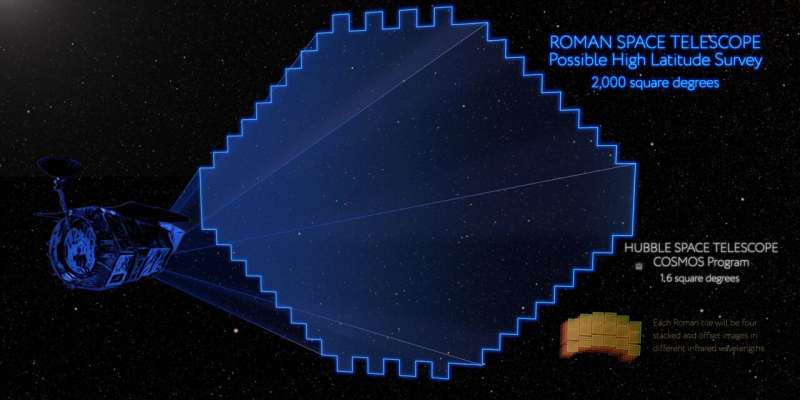A team of scientists has forecast the scientific impact of the Nancy Grace Roman Space Telescope's High Latitude Wide Area Survey on critical questions in cosmology. This observation program will consist of both imaging, which reveals the locations, shapes, sizes, and colors of objects like distant galaxies, and spectroscopy, which involves measuring the intensity of light from those objects at different wavelengths, across the same enormous swath of the universe. Scientists will be able to harness the power of a variety of cross-checking techniques using this rich data set, which promises an unprecedented look into some of cosmology's most vexing problems.
When it begins work in 2027, Roman will yield results that would be impossible to achieve using existing telescopes. Its impact will be further enhanced by teaming up with other new facilities like the Vera C. Rubin Observatory, a novel wide-field telescope now being built on the summit of Cerro Pachón in Chile. Scheduled to begin full operations by 2024, Rubin's planned 10-year survey extends across Roman's five-year primary mission.
"By predicting Roman's science return, we hope to help the scientific community develop the best strategy for observing the cosmos," said Tim Eifler, an assistant professor at the University of Arizona in Tucson. "We eagerly await the images and data the mission will send back to help us better understand some of the biggest mysteries in the universe."
The team's results are described in two papers led by Eifler and published in the October edition of the Monthly Notices of the Royal Astronomical Society. The study is part of an effort by a broader team of world-leading scientists to prepare to analyze Roman's cosmological data.
"Our study was only possible because of all the expertise, from theorists to observers, that is present in the larger team," Eifler said.
A multitalented observatory
The Roman mission owes its multifaceted approach to its combination of imaging and spectroscopy across an enormous field of view, which enables two main cosmological techniques: galaxy clustering and weak gravitational lensing. The first measures the exact positions of hundreds of millions of faint galaxies. Weak lensing measures how the images of galaxies have been distorted by the gravity of intervening matter. With its wide, deep view, Roman will allow scientists to study the structure and evolution of the universe and to explore the concept of cosmic acceleration as never before.
Learning about how the universe evolved to its present state will offer clues about what's speeding up the universe's expansion. In addition to weak lensing and galaxy clustering, Roman will study this mystery in several ways, including surveying the sky for a special type of exploding star called a type Ia supernova. The mission will also probe cosmic acceleration by measuring the masses and redshifts of galaxy clusters, the largest structures in the universe. The number and size of these structures depend on how the speed of the universe's expansion changes.
"Using several different methods to study the cause behind cosmic acceleration will help astronomers greatly reduce the uncertainty that has plagued expansion measurements," said Hironao Miyatake, an associate professor at Nagoya University in Japan and a co-author of the papers. "Each method will cross-check the others, which is one reason Roman will be able to provide extremely precise results."
Combining so many observational methods will allow astronomers to investigate additional mysteries, too, including determining the amount of dark matter—invisible matter that is detectable only through its gravitational effects—and tracking the growth of black holes in the early universe that form the seeds of massive galaxies.
"Roman is designed specifically to solve mysteries such as cosmic acceleration, but its enormous view of the universe will reveal a treasure trove of data that could help explain other puzzles as well," said Elisabeth Krause, an assistant professor at the University of Arizona and a co-author of the papers. "The mission could even help answer questions no one has thought to ask yet."
Teaming up with Rubin
Roman isn't the only observatory designed to probe cosmic acceleration. In one paper, the team explored how Roman will work hand-in-hand with another telescope: the Rubin Observatory. Named for American astronomer Vera Rubin, who showed that galaxies are mostly made of dark matter, the Rubin Observatory will use its 8.4-meter (27.4-foot) primary mirror to conduct a truly gigantic survey of the sky, covering about 44% of the sky over 10 years.
"Roman's observations will begin, in terms of wavelength, where Rubin's observations end," Eifler said. "Roman plans to view a smaller area of the sky, but it will see much deeper and generate clearer pictures since it will be located above Earth's atmosphere."
The current observing strategy for Roman's High Latitude Wide Area Survey will enable observations of about 5% of the sky—2,000 square degrees—over the course of about a year. However, the team illustrated how changing the survey's design could yield compelling results. The survey could be extended, for example, to cover more of the same area that Rubin will observe. Or it could observe galaxies using a single broad filter, instead of imaging with four separate ones, allowing faster observations while still retaining the survey's depth.
"It is exciting to consider the benefits we would gain from merging the two telescopes' observations," Krause said. "Roman will gain from Rubin's larger observing field, and Rubin will gain enormously from having some deeper observations with Roman's better image quality. The missions will greatly enhance each other."



